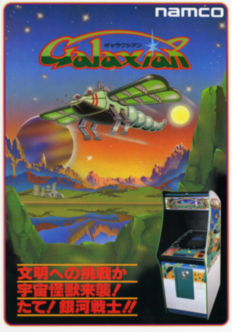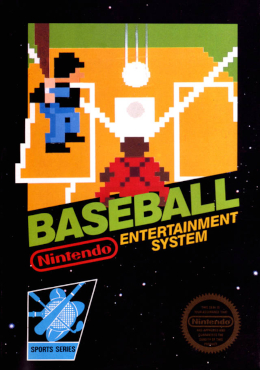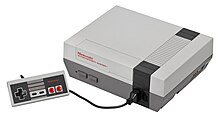The video game crash of 1983 was a large-scale recession in the video game industry that occurred from 1983 to 1985, primarily in the United States. The crash was attributed to several factors, including market saturation in the number of video game consoles and available games, many of which were of poor quality. Waning interest in console games in favor of personal computers also played a role. Home video game revenue peaked at around $3.2 billion in 1983, then fell to around $100 million by 1985. The crash abruptly ended what is retrospectively considered the second generation of console video gaming in North America. To a lesser extent, the arcade video game market also weakened as the golden age of arcade video games came to an end.

Data East Corporation, also abbreviated as DECO, was a Japanese video game, pinball and electronic engineering company. The company was in operation from 1976 to 2003, and released 150 video game titles. At one time, the company had annual sales of 20 billion yen in the United States alone but eventually went bankrupt. The American subsidiary, Data East USA, was headquartered in San Jose, California. Its main headquarters were located in Suginami, Tokyo.
1983 has seen many sequels and prequels in video games, such as Mario Bros. and Pole Position II, along with new titles such as Astron Belt, Champion Baseball, Dragon's Lair, Elevator Action, Spy Hunter and Track & Field. Major events include the video game crash of 1983 in North America, and the third generation of video game consoles beginning with the launch of Nintendo's Family Computer (Famicom) and Sega's SG-1000 in Japan. The year's highest-grossing video game was Namco's arcade game Pole Position, while the year's best-selling home system was Nintendo's Game & Watch for the third time since 1980.

In the history of video games, the third generation of video game consoles, commonly referred to as the 8-bit era, began on July 15, 1983, with the Japanese release of two systems: Nintendo's Family Computer and Sega's SG-1000. When the Famicom was released outside of Japan, it was remodeled and marketed as the Nintendo Entertainment System (NES). This generation marked the end of the video game crash of 1983, and a shift in the dominance of home video game manufacturers from the United States to Japan. Handheld consoles were not a major part of this generation; the Game & Watch line from Nintendo and the Milton Bradley Microvision that were sold at the time are both considered part of the previous generation due to hardware typical of the second generation.

Galaxian is a 1979 fixed shooter arcade video game developed and published by Namco. The player assumes control of the Galaxip starfighter in its mission to protect Earth from waves of aliens. Gameplay involves destroying each formation of aliens, who dive down towards the player in an attempt to hit them.

Dig Dug is a maze arcade video game developed by Namco in 1981 and released in 1982, distributed in North America by Atari, Inc. The player controls Dig Dug to defeat all enemies per stage, by either inflating them to bursting or crushing them underneath rocks.

The Nintendo VS. System is an arcade system that was developed and produced by Nintendo. It is based on most of the same hardware as the Family Computer (Famicom), later released as the Nintendo Entertainment System (NES). As Nintendo was planning to release the NES in North America, they were aware of the video game crash of 1983 and its effects on the home console market. However by March 1984 the arcade industry recovered enough for a plan to introduce NES titles there, with the VS. System later being a presentation to players who did not yet own the console. It became the first version of the Famicom hardware to debut in North America.

Kung-Fu Master, known as Spartan X in Japan, is a side-scrolling beat 'em up developed by Irem as an arcade video game in 1984, and distributed by Data East in North America. Designed by Takashi Nishiyama, the game was based on Hong Kong martial arts films. It is a loose adaptation of the Jackie Chan, Sammo Hung, and Yuen Biao film Wheels on Meals (1984), called Spartan X in Japan, with the protagonist Thomas named after Jackie Chan's character in the film. The game is also heavily inspired by the Bruce Lee film Game of Death (1972), which was the basis for the game's concept. Nishiyama, who had previously designed the side-scrolling shooter Moon Patrol (1982), combined fighting elements with a shoot 'em up gameplay rhythm. Irem and Data East exported the game to the West without the Spartan X license.

Ghosts 'n Goblins, known as Makaimura in Japan, is a platform video game developed by Capcom and released for arcades in 1985. It is the first game in the Ghosts 'n Goblins franchise, and has since been ported to numerous home platforms.

Commando, released as Senjō no Ōkami in Japan, is a vertically scrolling run and gun video game released by Capcom for arcades in 1985. The game was designed by Tokuro Fujiwara. It was distributed in North America by Data East, and in Europe by several companies including Capcom, Deith Leisure and Sega, S.A. SONIC. Versions were released for various home computers and video game consoles. It is unrelated to the 1985 film of the same name, which was released six months after the game.
The following article is a broad timeline of arcade video games.
1986 saw many sequels and prequels in video games, such as Super Mario Bros. 2, along with new titles such as Arkanoid, Bubble Bobble, Castlevania, Dragon Quest, Ikari Warriors, The Legend of Zelda, Metroid, Out Run and R.B.I. Baseball. The year's highest-grossing arcade video games were Hang-On in Japan, Hang-On and Gauntlet in the United States, and Nemesis (Gradius) in London. The year's best‑selling home system was the Nintendo Entertainment System (Famicom) for the third year in a row, while the year's best-selling home video games in Western markets were Super Mario Bros. in the United States and Yie Ar Kung-Fu in the United Kingdom.
1984 saw many sequels and prequels along with new titles such as 1942, Boulder Dash, Cobra Command, Jet Set Willy, Karate Champ, Kung-Fu Master, Yie Ar Kung-Fu and Punch-Out!! The year's highest-grossing arcade games were Pole Position in the United States, for the second year in a row, and Track & Field in the United Kingdom. The year's best-selling home system was Nintendo's Family Computer (Famicom), which was only sold in Japan at the time.
1979 saw many sequels and prequels in video games, such as Space Invaders Part II and Super Speed Race, along with new titles such as Asteroids, Football, Galaxian, Head On, Heiankyo Alien, Monaco GP, Sheriff and Warrior. For the second year in a row, the highest-grossing video game was Taito's arcade game Space Invaders and the best-selling home system was the Atari Video Computer System.

Mr. Do! is a 1982 maze game developed by Universal. It is the first arcade video game to be released as a conversion kit for other arcade machines; Taito published the conversion kit in Japan. The game was inspired by Namco's Dig Dug released earlier in 1982. Mr. Do! was a commercial success in Japan and North America, selling 30,000 arcade units in the US, and it was followed by several arcade sequels.

TX-1 is an arcade racing simulation game developed by Tatsumi and released in 1983. It was licensed to Namco, who in turn licensed it to Atari, Inc. for release in the United States, thus the game is considered a successor to Pole Position and Pole Position II. It was also released in the United Kingdom, Ireland and mainland Europe via Atari Ireland.

Baseball is a video game from Nintendo. It was released December 7, 1983, after the July 15 launch of the Famicom in Japan. In 1984, it was ported to the VS. System arcade as VS. Baseball with additional graphics and speech, becoming a number one hit in Japan and North America that year. It was localized as a Nintendo Entertainment System launch game in North America in 1985, and in Europe in 1986. IGN said the universal appeal of the American sport made Baseball a key to the NES's successful test market introduction, and an important piece of Nintendo history. The game was also competing with Sega's arcade hit Champion Baseball, released earlier in 1983.

Star Force, also released in arcades outside of Japan as Mega Force, is a vertical-scrolling shooter computer game released in 1984 by Tehkan.
The 1980s was the second decade in the industry's history. It was a decade of highs and lows for video games. The decade began amidst a boom in the arcade business with giants like Atari still dominating the American market since the late-1970s. Another, the rising influence of the home computer, and a lack of quality in the games themselves led to an implosion of the video game market that nearly destroyed the industry in North America. It took home consoles years to recover from the crash, but Nintendo filled in the void with its Nintendo Entertainment System, reviving interest in consoles. Up until this point, most investors believed video games to be a fad that has since passed. In the remaining years of the decade, Sega ignites a console war with Nintendo, developers that had been affected by the crash experimented with the more advanced graphics of the PC, and Nintendo released the Game Boy, which would become the best-selling handheld gaming device for the next two-decades. Other consoles releases in the decade included the Intellivision, TurboGrafx-16 and Sega Genesis. Notable games of the 1980s included Super Mario Bros, Duck Hunt, Metroid, Elite, SimCity, Galaga,Pitfall!, Frogger, Mike Tyson's Punch-Out!!, Defender, Mega Man 2, The Legend of Zelda, Castlevania, Ghosts 'n Goblins, Super Mario Bros. 2, Bubble Bobble, Double Dragon,Final Fight, Ninja Gaiden,Tetris, Adventure, Joust, Robotron: 2084, Pac-Man, Dig Dug, Arkanoid,Populous, R-Type, Contra, Donkey Kong, Centipede, Super Mario Bros. 3, Prince of Persia, Sid Meier's Pirates!, Where in the World Is Carmen Sandiego?,Gauntlet, Dragon's Lair, Golden Axe, Ms. Pac-Man, Out Run, Dungeon Master,Final Fantasy, Altered Beast, Shinobi, Lode Runner, Battlezone,Dragon Quest, Ultima IV: Quest of the Avatar, and Marble Madness.

Tehkan World Cup, originally released as World Cup in Japan, is an association football video game released to arcades in 1985 by Tehkan, the former name of Tecmo. It features multiplayer gameplay and trackball controllers. It was released in both upright and table arcade cabinets, but was most commonly released in a cocktail cabinet form factor. Its arrival coincided with the buildup to the 1986 FIFA World Cup. It featured the then colors of several of the world's top teams such as West Germany, Argentina and Brazil, although it did not mention any team by name.













